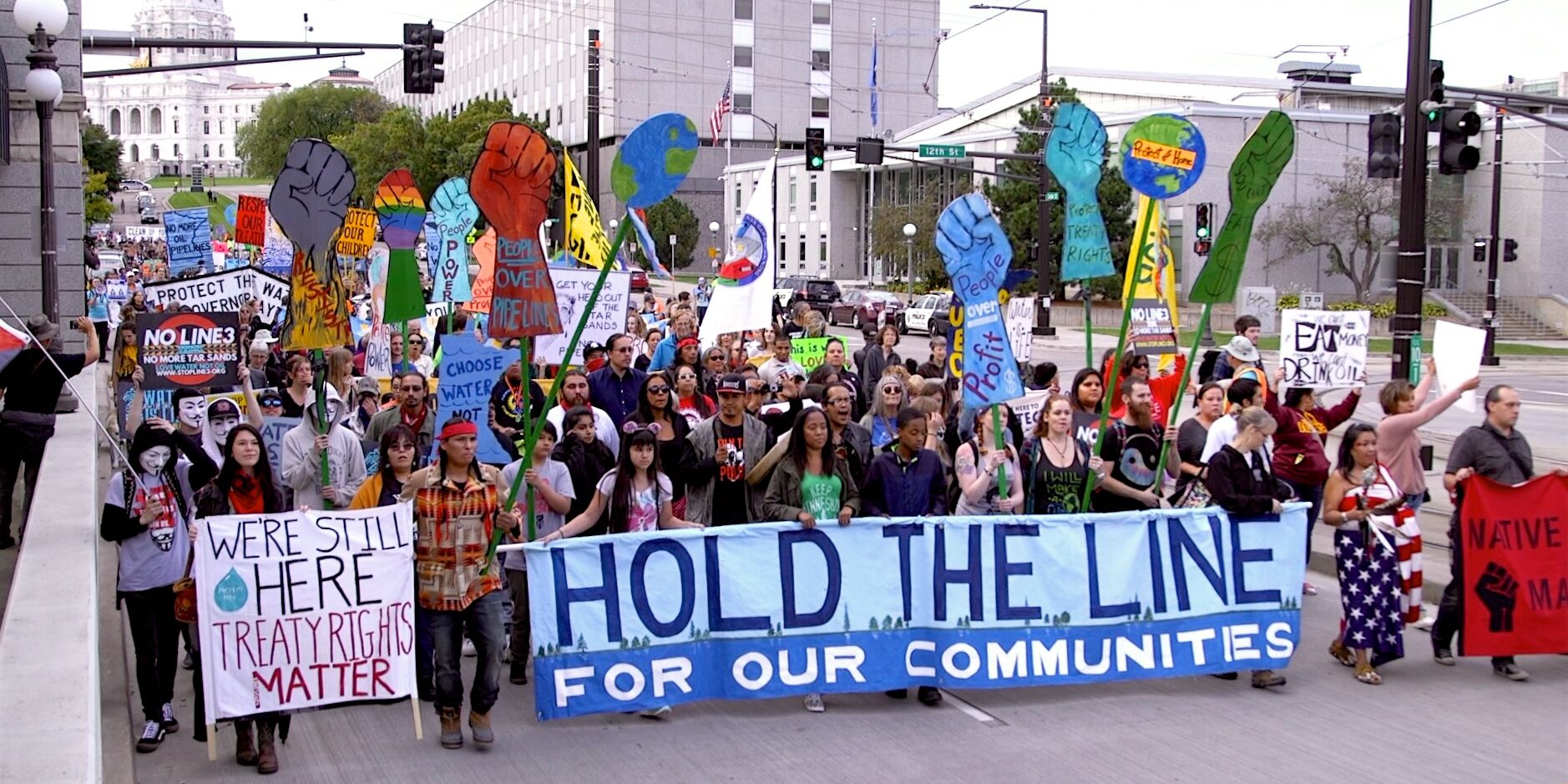My Response to Insight News: Environmental Justice means No Line 3
By Analyah A. Schlaeger dos Santos
Background: In April 2019, local media outlets Insight News and the Minneapolis Spokesman-Recorder published articles titled “Environmental Racism Grows as Environmental Groups Turn Increasingly White” and “Mostly White environmental groups downplay Black issues,” both written by Washington D.C.-based media consultant Hazel Trice Edney. The articles have been widely criticized by the Minnesota climate justice community as divide-and-conquer pieces. This comes in context of a massive PR campaign for the Enbridge Line 3 Pipeline (see “Pro Line 3 Group Drops $247,000 on Facebook Ads“).
In response, MNIPL staff member Analyah A. Schlaeger dos Santos wrote this letter to Insight News and the Minneapolis Spokesman-Recorder, dated May 5, 2019. Anaylah is MNIPL’s Environmental Justice Youth Program Coordinator and a native of North Minneapolis. The letter speaks to the environmental justice concerns at the heart of the movement to stop the Line 3 pipeline, which is led by local indigenous frontline communities.
To Whom It May Concern:
Regarding the recent article titled “Environmental Racism Grows as Environmental Groups Turn Increasingly White,” published April 19 on InsightNews.com, I’d like to address some discrepancies between what was stated and what actually happens in the Climate Justice Movement here in Minnesota.
Presently, I work as an Environmental Justice Youth Program Coordinator for Minnesota Interfaith Power and Light. I am an Afro-Brazilian, Euro-American woman, a North Minneapolis resident, and a young person that has the privilege of working directly with other youth on environmental justice issues as they pertain to the Minnesota community primarily, and the world secondarily.
My work has been consistently moulded to create a Diversity, Equity, and Inclusion (DEI) framework, and models the kind of Environmental Justice lens that our society so desperately needs. Throughout my work, I have been deeply impressed and proud to witness firsthand the connections that are forming here in the climate justice movement, especially among people of color. Through this, I know just how heavily the movement depends on collaboration and co-creation.
I am disappointed, to say the least, in how the article in question only seeks to divide and conquer.
The environmental movement in America has historically only been recognized as legitimate at privileged, mostly white tables. Still, communities of color (especially Indigenous communities) have always been and continue to stand at the forefront of environmental stewardship. In my own neighborhood, for example, the Environmental Justice Coordinating Committee formed from a group of concerned North Minneapolis residents of color to address issues as they pertain to residents of the Northside community, educating on environmental matters and how we as a united community can tackle them head-on.
At Minnesota Interfaith Power & Light, the Just B Solar summer camp taught youth in North Minneapolis how to find a meaningful place in the solar energy movement, also led by community members of color. And this summer, the Youth N’ Power Summer camp will teach youth in grades 5-12 how to be stewards to our environment here in Minnesota, how to advocate for themselves in realm of environmental policy, and in turn, how to create positions in the business world that they want to fulfill. There are countless local examples of people of color, people in Black communities, and white allies coming together to create the kind of change that we want for our home.
Speaking of our home here in Minnesota, it is key that I address the fallacies stated in the aforementioned article with this piece of information: Minnesota is Native Dakota and Anishinaabe land. Any project that seeks to threaten the natural state of Minnesota is a direct threat to our Indigenous siblings – communities whose livelihoods continue to depend on State-occupied land. Those of us who are actually rooted in Environmental Justice here recognize this fact, and partner with Native communities to address issues that specifically impact Minnesotans.
Another very important clarification: the movement to stop Line 3 in Minnesota is an Indigenous-led fight, made by and for people of color with the platform to defend Native sovereignty and well-being. To paint this movement as “primarily white-led environmental groups” wasting their time on a pet project completely whitewashes the movement and erases all of the work that Anishinaabe and Dakota leaders in particular have put into this effort.
Additionally, Minnesota houses the starting point of the Mississippi River – a river that runs the length of the United States from North to South. The proposed Enbridge Pipeline would cross this river that we hold so dear not just once, but twice. The chosen route of this pipeline is a prime example of environmental racism. It would cut through crucial fishing, hunting, and gathering lands on treaty territory of the Anishinaabe people. There is an important truth to explore in the article’s criticism of white dominance in Minnesota’s environmental movement, but if that was her goal, the author profoundly missed the mark. Edney’s claim that Minnesota’s anti-pipeline activism is first and foremost a white-led, single-issue focus for big national NGOs is simply false, on many counts. Additionally, to imply that pipeline oil spills, deforestation, and the pollution that oil creates is NOT an issue that affects everyone, directly contradicts what Hazel advocates for earlier in bringing up air pollution and clean water issues as they pertain to communities of color.
While roach dust and lead paint are toxic and important issues, poisoning our drinking water by advocating for a tar sands pipeline is a direct blow to not only communities of color and everyone who needs water to survive, but creates a deeper divide between us as a people. And for the article’s crafter to claim that pipelines are “one of the safest and least costly ways to transport energy products,” tells me as someone who is actually doing work to bring folks together and heal our planet, that the author knows not one bit about the realm in which she seeks to comment.
To wrap up a decidedly long-winded rebuttal, I want to illuminate one of the key missions of the Trice Edney News Wire, which published this article: “As we educate a nation about the racial imbalances that prevail in every city, town, and precinct, we aim to impact lives, inspire hope, and motivate change…. At the Trice Edney News Wire, our highest values are quality and integrity. And we are guided by our commitment to the eternal principles of truth, equality, freedom, and justice for all.” {Taken Directly from www.nationalnewsreleases.com }.
The article in question does not uphold a mission of maintaining integrity through seeking truth, inspiring hope, or motivating actual change; it does not uplift Black and Brown communities to seek justice and advocate for ourselves; it does not create positive impact. And it does not educate a nation. It merely spreads more unnecessary false narratives and enables divisive culture, not unlike the white-led systems that have always been forced as a means of keeping us down and divided. Seeing as those of us that feel strongly enough to respond to your notably under/misinformed statements are actually doing the work here in Minnesota, our home, and are made up of a myriad of peoples of color and allies, young and old alike: I implore you, Miss Hazel Trice Edney, to take a day or two and come visit Minnesota, so that we may welcome you with open arms to join the fight to protect what is lovely and sacred about this place; to seek not to divide and dramatize, but instead to make space so that people of color (like myself) who call this place home may take pride in educating ourselves and protecting that which we know and love.
Abundant Blessings,
Analyah A. Schlaeger dos Santos
Environmental Justice Youth Program Coordinator
Minnesota Interfaith Power & Light

